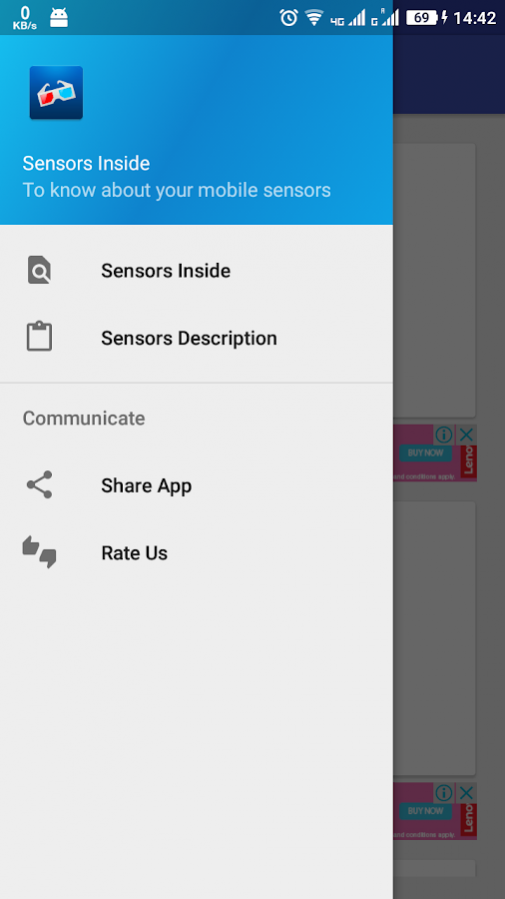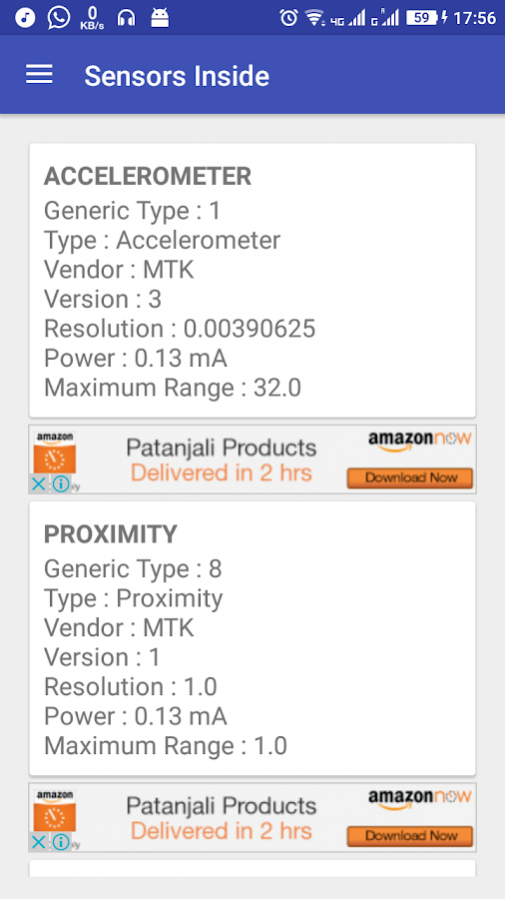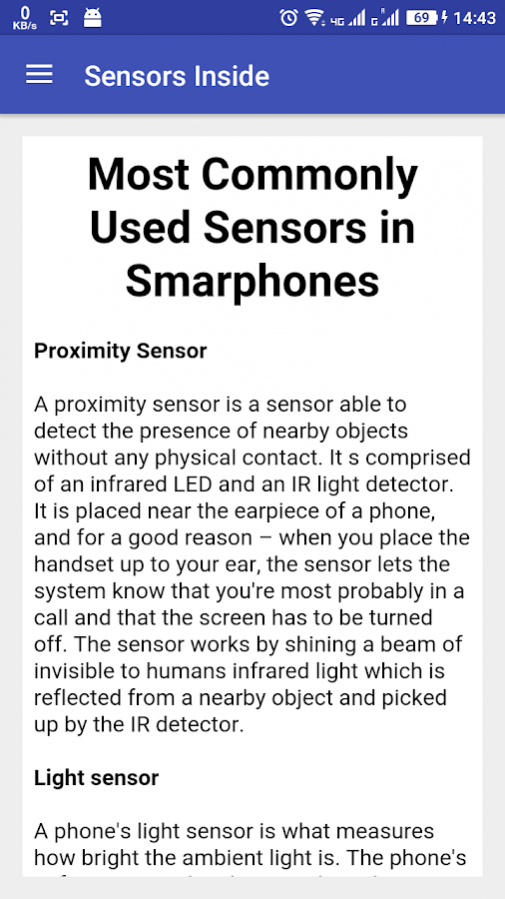Sensors Inside 1.2
Free Version
Publisher Description
Using this application you will get to know about sensors available in your mobile.
It is handy in following circumstances and whenever you are in the need of sensor details
1. To verify and compare the sensor availability on different mobiles
2. To know about sensor properties and values
3. To calibrate the sensors
Most commonly used sensors in smartphones
Proximity Sensor
A proximity sensor is a sensor able to detect the presence of nearby objects without any physical contact. It s comprised of an infrared LED and an IR light detector. It is placed near the earpiece of a phone, and for a good reason – when you place the handset up to your ear, the sensor lets the system know that you're most probably in a call and that the screen has to be turned off. The sensor works by shining a beam of invisible to humans infrared light which is reflected from a nearby object and picked up by the IR detector.
Light sensor
A phone's light sensor is what measures how bright the ambient light is. The phone's software uses this data to adjust the display's brightness automatically – when ambient light is plentiful, the screen's brightness is pumped up, and when it is dark, the display is dimmed down. An interesting fact is that high-end Samsung Galaxy phones use an advanced light sensor that can measure white, red, green, and blue light independently. And that's not overkill. In fact, the Adapt Display feature uses this data to fine tune image representation.
Barometer
Higher-end phones have a built-in barometer – a sensor that can measure atmospheric pressure. Data measured by it is used to determine how high the device is above sea level, which in turn results in improved GPS accuracy.This sensor is really cool
Magnetometer
The digital compass that's usually based on a sensor called magnetometer provides mobile phones with a simple orientation in relation to the Earth's magnetic field. As a result, your phone always knows which way is North so it can auto rotate your digital maps depending on your physical orientation.
Hall Sensor
A Hall effect sensor is a transducer that varies its output voltage in response to a magnetic field. Hall effect sensors are used for proximity switching, positioning, speed detection, and current sensing applications.
The main function of this proximity sensor is to detect how close your smartphone's screen is to your body. When you use your smartphone, it detects the position of ear with respect to screen and turns off the light of screen and saves battery. Also proximity sensor stops the accidental touch, unwanted input during talk.
Accelerometers
Accelerometers (Gravity Sensors)are devices that can measure acceleration (the rate of change in velocity), but in smartphones, they're able to detect changes in orientation and tell the screen to rotate. Basically, it helps the phone know up from down.
Gyroscope
The gyroscope is a sensor that can provide orientation information as well, but with greater precision. Thanks to this particular sensor, Android's Photo Sphere camera feature can tell how much a phone has been rotated and in which direction. It is also used by Google's Sky Map for telling what constellation you're pointing a phone at.
Thermometer
Some folks might remember that the Samsung Galaxy S4 bragged with a thermometer for measuring ambient temperature. However, there's a thermometer in pretty much any smartphone, and some handsets might have more than one of them. The difference is that they're used to monitor the temperature inside the device and its battery. If a component is detected to be overheating, the system shuts itself down to prevent damage. And speaking of the Galaxy S4, it pioneered the use of an air humidity sensor in a smartphone. Data provided by it was used in the S Health application to tell whether or not the user was in their "Comfort Zone"
Thanks for installing our application !!! Please share your feedback as comment or do mail us !!!
About Sensors Inside
Sensors Inside is a free app for Android published in the System Maintenance list of apps, part of System Utilities.
The company that develops Sensors Inside is Spark Ideas. The latest version released by its developer is 1.2.
To install Sensors Inside on your Android device, just click the green Continue To App button above to start the installation process. The app is listed on our website since 2017-10-27 and was downloaded 5 times. We have already checked if the download link is safe, however for your own protection we recommend that you scan the downloaded app with your antivirus. Your antivirus may detect the Sensors Inside as malware as malware if the download link to idea.spark.in.sensorsinside is broken.
How to install Sensors Inside on your Android device:
- Click on the Continue To App button on our website. This will redirect you to Google Play.
- Once the Sensors Inside is shown in the Google Play listing of your Android device, you can start its download and installation. Tap on the Install button located below the search bar and to the right of the app icon.
- A pop-up window with the permissions required by Sensors Inside will be shown. Click on Accept to continue the process.
- Sensors Inside will be downloaded onto your device, displaying a progress. Once the download completes, the installation will start and you'll get a notification after the installation is finished.



